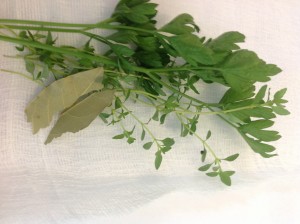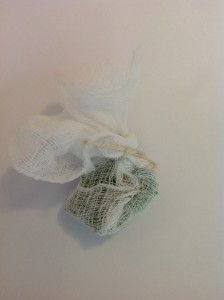hospital dinner tray
What is blander than the pureed food fed to hospital patients and in Perpetua to individuals with swallowing disorders? Pale, anemic foods that taste exactly like they look? Totally blah! So…adding seasoning to food enhances the pleasure of eating. Bland food is not food that stimulates the appetite or brings pleasure to eating. One solution is adding seasoning: fresh or dried herbs and spices, zesty marinades. But the problem we face here is that spices or herbs may remain as small particles once the food is cooked and ready to be served, and it’s the potential for particles to fall into the airway that we worry about.
One solution is to strain the cooked food through a double strainer  [this is an 8 inch double fine strainer available from Amazon or from
[this is an 8 inch double fine strainer available from Amazon or from
http://www.webstaurantstore]
Such a strainer can take out all left over particles, and that’s a good solution; and it also helps to blend the food and make it more cohesive. But there are other means to the goal of having well-seasoned food.
One such means is the French bouquet garni, a combination of parsley, thyme and bay leaf tied into a piece of washed cheesecloth. The herbs thus do not disperse themselves [nor leave particles behind for potential aspiration hazard] and can be readily removed. Garlic, chilis, or other herbs can be treated in a similar manner. 
Ingredients in a bouquet garni
The classic bouquet garni is pictured above. My talents in terms of cutting cheesecloth are limited: it always seems sort of hacked off, but we’re not after winning beauty contests here. I use fresh or dried herbs in most foods I cook and aim for variety: oregano, basil, tarragon, in addition to the ones in the classic bouquet garni.
Another way of dealing with the issue is to infuse herbs or spices into an oil, heat them thoroughly until their aroma is released, then strain them, so that the oil carries the flavor. It’s called insaporire in Italian. Rachel of the blog “Rachel Eats”, describes the the process where garlic is infused into oil : allowing “the garlic to impart its savory and perfume into the oil—then like a good guest, neither dominating or outstaying his welcome—taking leave.” [Rachel Eats, June 23, 2013]. It works well with other herbs, too. Make an infusion, for example, of rosemary and thyme, or of parsley & tarragon. Heat these in half a cup of olive oil until the herbs begin to fill the room with aroma; remove from heat, strain through cheesecloth or a double strainer, bottle and use the oil for simmering fish, vegetables, poultry. Here’s a helpful website: http://www.exploratorium.edu/cooking/seasoning/kitchen/recipe-oils.html
You can do cold infusions, too. Same idea, really, but you let them sit in a bottle after you’ve added the hot oil for a couple of weeks.
Here’s one of my infusions that I’ll use to poach fish tonight:
It’s just rosemary & thyme in a good olive oil. How good, the olive oil? Pretty good. Not my very best, but the one I use for cooking





